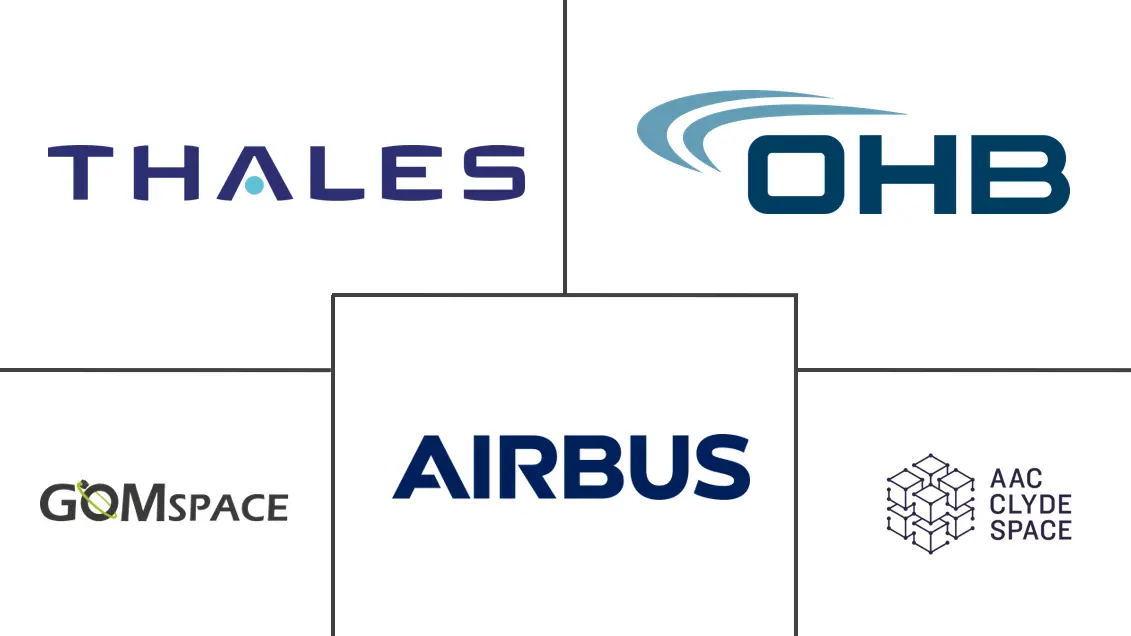Europe Satellite Attitude And Orbit Control System Market Size and Share
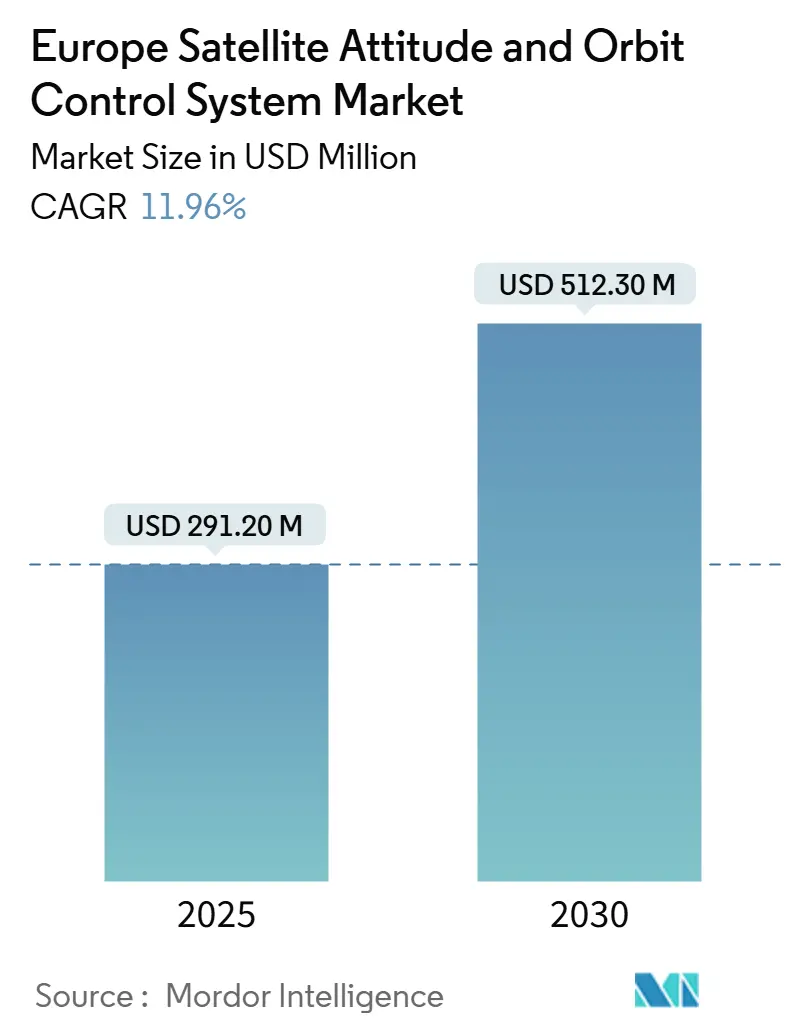
Europe Satellite Attitude And Orbit Control System Market Analysis by Mordor Intelligence
The Europe satellite attitude and orbit control system (AOCS) market size stands at USD 291.20 million in 2025. It is forecasted to climb to USD 512.30 million by 2030, translating into an 11.96% CAGR over the period. Rapid growth springs from the European Union’s IRIS² constellation, expanded European Space Agency (ESA) funding, falling commercial-off-the-shelf (COTS) component costs, and the spread of AI-enabled autonomous control that trims ground-station workloads. Commercial end-users remain the biggest revenue driver, yet military demand is accelerating as governments seek dual-use platforms for resilience and strategic autonomy. Mid-range 100 to 500 kg satellites dominate volumes, while sub-100 kg spacecraft post the fastest growth thanks to CubeSat constellations and Europe’s emerging microlaunchers. Competitive intensity is moderate; traditional primes must now compete with nimble software-defined AOCS specialists focusing on machine-learning algorithms and modular hardware. Export controls, radiation-qualification costs, and debris-mitigation rules temper the otherwise robust outlook.
Key Report Takeaways
- By application, communication held 44.75% of 2024 revenue in the European satellite AOCS market, whereas Earth observation is projected to expand at a 9.71% CAGR to 2030.
- By satellite mass, the 100 to 500 kg class accounted for 46.75% of 2024 revenue, while the 10 to 100 kg segment is set to post a 9.83% CAGR through 2030.
- By orbit class, LEO satellites comprised 46.32% of 2024 deployments; MEO platforms lead growth at 9.91% CAGR to 2030.
- By end-user, commercial operators captured 47.69% of 2024 demand, yet military and government users record the highest projected CAGR at 10.52% to 2030.
- By geography, the United Kingdom controlled 35.22% of 2024 revenue, while France is expected to grow the fastest at 10.23% CAGR through 2030.
Europe Satellite Attitude And Orbit Control System Market Trends and Insights
Drivers Impact Analysis
| Driver | (~) % Impact on CAGR Forecast | Geographic Relevance | Impact Timeline |
|---|---|---|---|
| Surge in small-satellite constellations for earth observation (EO) and Internet of Things (IoT) | +3.2% | EU-wide, concentrated in United Kingdom, Germany, France | Medium term (2-4 years) |
| ESA and national funding expansion | +2.8% | EU member states, Norway, Switzerland | Long term (≥ 4 years) |
| Declining COTS component costs | +2.1% | EU manufacturing hubs | Short term (≤ 2 years) |
| Demand for in-orbit servicing and debris mitigation | +1.9% | EU-wide, focus on France and Germany | Long term (≥ 4 years) |
| AI-based autonomous AOCS algorithms | +1.6% | Technology hubs in United Kingdom, Germany, Netherlands | Medium term (2-4 years) |
| European microlaunchers enabling custom orbits | +1.4% | Launch sites in Germany, Spain, United Kingdom | Medium term (2-4 years) |
| Source: Mordor Intelligence | |||
Surge in Small-Satellite Constellations for EO and IoT
The EU-backed IRIS² program will place 290 satellites in orbit by 2030, compelling attitude-and-orbit-control suppliers to deliver autonomous formation-flying and collision-avoidance capabilities that operate seamlessly across hundreds of spacecraft.[1]European Commission, “IRIS² Constellation Programme,” ec.europa.eu is building common software frameworks that let different manufacturers plug standardized AOCS modules into multi-vendor constellations, shortening integration cycles and lowering costs.[2]European Space Agency, “ClearSpace-1 Mission to Launch in 2026,” esa.int Constellation economics demand sub-meter pointing accuracy at price points 60-80% below legacy GEO hardware, pushing European vendors to adopt modular star trackers and scalable reaction-wheel clusters. Real-time fleet management also raises the bar for onboard autonomy, since human operators cannot micromanage every satellite in flocks that exceed 100 nodes. As a result, platforms combining precision, affordability, and AI-driven self-coordination are emerging as clear winners within the European satellite AOCS market.
ESA and National Funding Expansion
ESA’s 2024-2025 budget rose 17% to USD 8.97 billion, with fresh allocations for quantum sensors and AI-navigation research directly supporting next-generation AOCS programs.[3]European Space Agency, “ESA Budget 2024,” esa.int Germany’s USD 1.4 billion space plan and France’s USD 10.49 billion infrastructure push reinforce that momentum, underwriting prototype flights and component-qualification campaigns through 2030. Funding packages emphasize dual-use technology, ensuring that civil and defense satellites can share common AOCS architectures for economies of scale. Cooperative schemes like ESA’s ARTES speed laboratory concepts like neuromorphic processors into orbit, widening Europe’s innovation gap versus regions with narrower public budgets. For suppliers, generous grants offset high non-recurring engineering costs, accelerating time to market for advanced attitude-control solutions.
Declining COTS Component Costs
Leveraging automotive and consumer-electronics lines, European manufacturers have cut star-tracker and inertial-measurement-unit prices by up to 50% compared with traditional space-qualified builds.[4]Airbus Defence and Space, “Small Satellite Solutions,” airbus.com Radiation tolerance is achieved through software error-correction and redundant architectures rather than costly custom chips, keeping prices low without sacrificing reliability. Falling hardware costs let CubeSat operators incorporate high-precision pointing capability once reserved for multi-ton platforms, broadening the customer base of the European satellite AOCS market. Procurement priorities are shifting, too; buyers now weigh software-update cadence and cybersecurity hardening on par with mechanical pedigree, rewarding vendors that bring agile firmware practices into the space domain.
Demand for In-Orbit Servicing and Debris Mitigation
ESA’s ClearSpace-1 mission, slated for launch in 2026, sets stringent benchmarks for sub-centimeter rendezvous maneuvers that future servicing spacecraft must meet. I vehicles require AOCS stacks capable of real-time trajectory optimization and vision-based navigation around non-cooperative targets. Commercial life-extension contracts increasingly specify standardized docking adapters and software hooks for servicing, embedding these AOCS requirements early in satellite design. As EU regulations tighten end-of-life disposal mandates, operators view autonomous de-orbit or servicing readiness as insurance against fines and revenue loss, creating durable demand for proximity-operation sensors and high-authority thrusters.
Restraints Impact Analysis
| Restraint | (~) % Impact on CAGR Forecast | Geographic Relevance | Impact Timeline |
|---|---|---|---|
| Export restrictions on space-grade parts | -2.3% | EU-wide, especially United Kingdom post-Brexit | Long term (≥ 4 years) |
| High radiation-qualification costs | -1.8% | EU test facilities and manufacturing centers | Medium term (2-4 years) |
| Vulnerability to space weather | -0.5% | Technology leaders: UK, Germany, Netherlands | Medium term (2-4 years) |
| AOCS engineering talent shortage in SMEs | -1.2% | Technology leaders: UK, Germany, Netherlands | Short term (≤ 2 years) |
| Source: Mordor Intelligence | |||
Export Restrictions on Space-Grade Parts
ITAR and EU dual-use regulations extend development schedules by up to 25% as companies navigate licensing for gyroscopes and micro-thrusters.[5]Reuters, “Europe Space Industry Grapples with Export Controls,” reuters.com Post-Brexit, United Kingdom firms must secure separate clearances when collaborating with EU partners, hiking transaction costs and complicating supply chains. Sanctions on Russian components further squeeze sourcing, pushing European primes to reengineer legacy platforms around indigenous parts. Larger firms absorb compliance overhead through dedicated export-control teams, but small and medium enterprises struggle, which could slow new-entrant momentum unless the EU accelerates domestic semiconductor initiatives.
High Radiation-Qualification Costs
Radiation testing can swallow as much as 50% of non-recurring engineering budgets for advanced AOCS electronics, with European facilities often booked 12-18 months out. AI-centric processors demand exhaustive fault-injection campaigns to validate soft-error resilience, lengthening cycles further. ESA is funding new irradiation centers in Belgium and Italy and standardizing test protocols to relieve bottlenecks, yet full capacity will not arrive until 2027. Until then, SMEs sometimes launch with commercial-grade components and accept shorter lifetimes, limiting their appeal for government payloads that insist on >15-year reliability.
Segment Analysis
By Application: Communication Leadership Confronts Earth-Observation Momentum
Communication satellites delivered 44.75% of 2024 revenue within the European satellite AOCS market, supported by broadband rollouts and sovereign connectivity initiatives. EO platforms, however, post the fastest 2025-2030 advance at 9.71% CAGR, propelled by Copernicus expansion and climate-monitoring missions that demand tighter pointing accuracy for hyperspectral instruments.
Constellation operators pursuing hybrid 5G-satellite networks now embed agile AOCS stacks to reassign beams in response to terrestrial cell-site congestion. Conversely, Earth-observation designers emphasize coordinated ground-track repeatability, prompting investment in high-performance star trackers and torque-rod systems resilient to orbital temperature swings. The European satellite AOCS market maintains robust opportunity diversity across navigation, space-science, and space-situational-awareness (SSA) payloads.
Navigation spacecraft, chiefly the Galileo constellation, prioritize atomic-clock stability, demanding AOCS subsystems to damp micro-vibrations from reaction wheels. SSA missions rely on rapid retargeting to track debris or near-Earth objects, necessitating high-torque control-moment gyros capable of large slews in seconds. The shift towards multi-mission satellites pressures suppliers to create firmware-defined attitude modes that operators can toggle post-launch, enhancing revenue potential throughout the satellite’s lifespan.
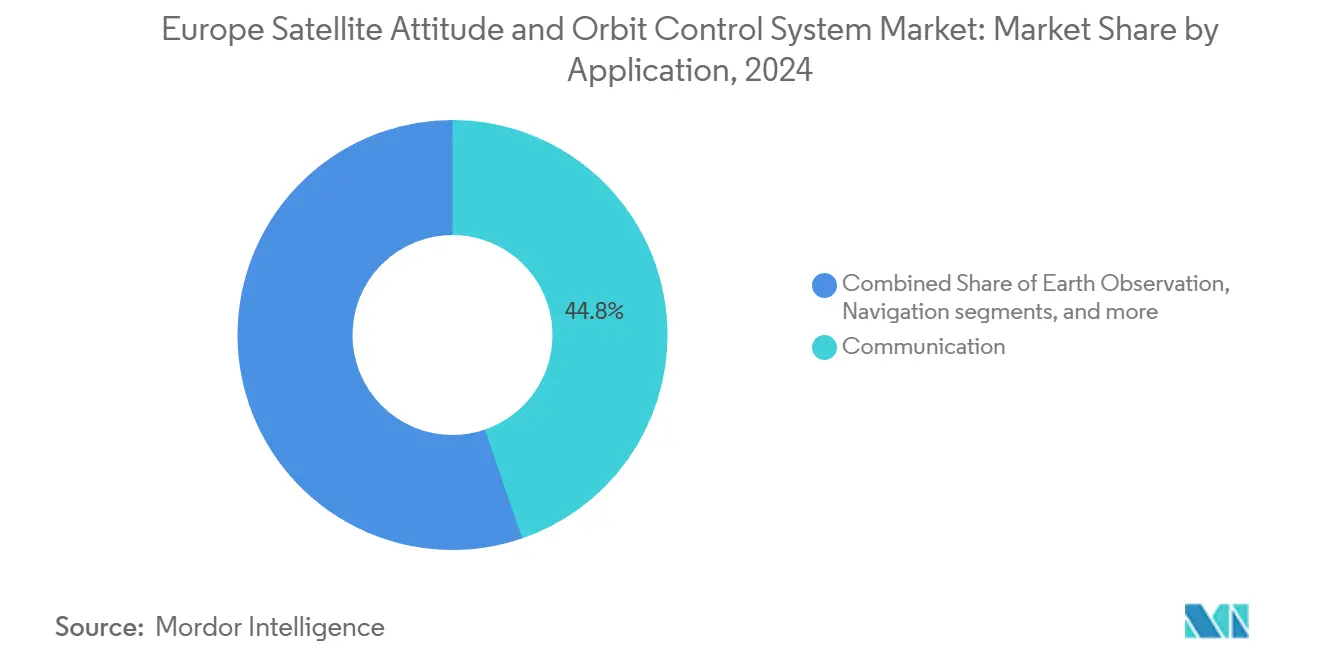
Note: Segment shares of all individual segments available upon report purchase
By Satellite Mass: Mid-Range Dominance Meets CubeSat Surge
The 100 to 500 kg class generated 46.75% of 2024 revenue in the Europe satellite AOCS market, favored for its balance of payload capacity and rideshare economics. Yet units between 10 kg and 100 kg, mostly CubeSats, are projected to capture an incremental 9.83% CAGR, reshaping supplier roadmaps toward miniaturized wheels, cold-gas thrusters, and low-power avionics. Affordability gains through automotive-grade sensors accelerate the CubeSat curve. However, maintaining arc-second pointing remains a hurdle, motivating research into micro-reaction wheel vibration isolation and low-jitter integrated star-tracker assemblies. Mass-modular platforms diversify risk by distributing mission objectives across multiple satellites; however, scaling fleets introduces fleet-management complexity. Providers respond with ground-segment software that orchestrates attitude tasks across hundreds of nodes, applying AI to predict momentum buildup and schedule momentum dumps fleet-wide.
At the upper end, 500 to 1,000 kg platforms cater to high-resolution optical imagers and scientific instruments requiring precise thermal control. These missions command premium margins while representing a smaller share, ensuring continued demand for high-end European AOCS components such as optical gyroscopes and magnetic-bearing reaction wheels.
By Orbit Class: LEO Still Largest, MEO Fastest
LEO satellites represented 46.32% of 2024 deployments in the European satellite AOCS market, attracting commercial data and connectivity services that benefit from low-latency links. MEO systems, led by Galileo augmentation and regional constellations, are forecast to expand at a 9.91% CAGR, reflecting operators’ desire for fewer spacecraft while retaining near-global coverage. LEO missions favor AOCS architectures that handle atmospheric drag and frequent station-keeping, whereas MEO spacecraft demand long-term pointing stability to support tri-frequency navigation signals.
The Europe satellite AOCS market share for MEO is set to inch upward as new timing and authentication services emerge. Geostationary platforms continue to underpin broadcast and governmental secure-comms, yet their share slowly erodes as LEO constellations mature. Orbital-debris-mitigation guidelines now require controlled re-entry or graveyard-orbit transfer at end-of-life, prompting inclusion of additional propellant margin and autonomous disposal algorithms within AOCS flight software. Emerging highly-elliptical orbits aimed at Arctic coverage introduce fresh control challenges, such as high dynamic range in angular rates, spurring specialized sensor development.
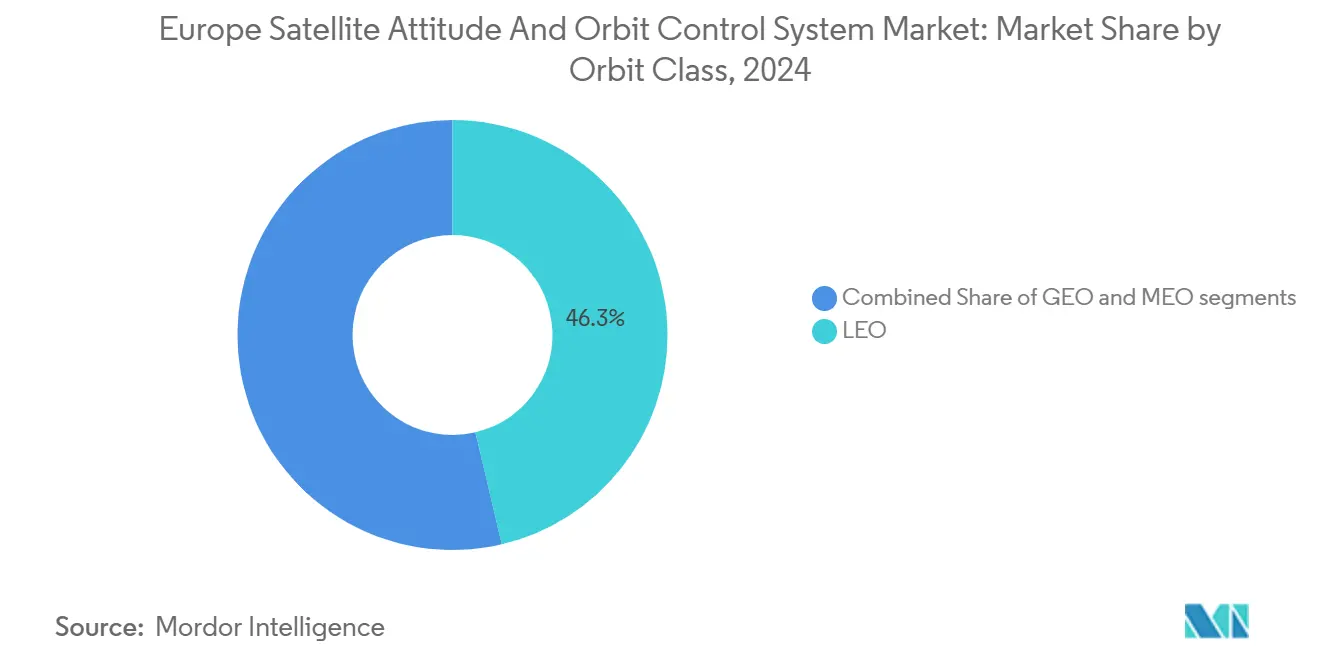
By End User: Commercial Lead, Military Upswing
Commercial operators captured 47.69% of 2024 demand, reflecting Europe’s thriving new-space sector and venture-capital inflows into data-as-a-service business models. However, Military and government customers headline growth with a 10.52% CAGR to 2030, fueled by strategic autonomy policies and the recognition that space assets underpin defense and economic security. Dual-use AOCS platforms allow hardware reuse across civil and defense missions, trimming procurement cycles. The Europe satellite AOCS market size allocated to defense payloads is forecast to add USD 75 million during the outlook period. Research institutions and international organizations inject niche requirements, such as microgravity manufacturing, that push AOCS envelopes toward ultra-stable platforms. Simultaneously, commercial satellite servicing firms seek scalable AOCS kits certified for close-proximity operations with legacy craft. This juxtaposition of volume-driven commercial orders and high-specification government missions compels suppliers to maintain broad product lines, balancing cost efficiency and performance differentiation.
Geography Analysis
The United Kingdom accounted for 35.22% of 2024 revenue in the European satellite AOCS market, buoyed by a mature supply chain and government funding streams like the GBP 374 million National Space Strategy.[6]UK Government, “National Space Strategy,” gov.uk Local primes Surrey Satellite Technology and Spirent Federal harness legacy know-how in precision navigation sensors, reinforcing the UK’s export credentials. Despite customs frictions after Brexit, Britain leverages bilateral agreements with Australia, Japan, and the United States to sustain component flows, albeit under stricter export licenses. Investment incentives in Scottish spaceports and Welsh test ranges further underpin domestic demand for advanced AOCS.
France's fastest expansion is projected at 10.23% CAGR through 2030, reflecting CNES and Defense procurement bolstering programs such as Syracuse 4 and the new optical-reconnaissance constellation. Thales Alenia Space and Airbus Defence and Space anchor an ecosystem from star-tracker fabrication in Cannes to reaction-wheel integration in Toulouse. Talent pipelines from French engineering grandes écoles feed R&D into AI-driven attitude controllers. Version two Copernicus Sentinel satellites add incremental AOCS orders focused on thermal and radiation robustness, given extended mission lives in sun-synchronous orbits.
Germany follows, capitalizing on high-precision manufacturing in Bavaria and Lower Saxony, where OHB, Tesat-Spacecom, and emerging start-ups refine optical comms and quantum inertial sensors. Federal grants channel USD 1.4 billion toward national space projects, emphasizing sovereign parts supply to ease ITAR exposure. Italy, Spain, and the Netherlands round out the geographic spread, each leveraging targeted incentives: Italy’s collaboration with Leonardo builds momentum in gyroscope production; Spain’s LauncherOne-class boosters drive demand for plug-and-play AOCS; the Netherlands’ space-weather observatories call for high-dynamic-range attitude sensing suited to polar passes. Collectively, these hubs diffuse dependency on a single champion, aligning with Brussels’ objective of a resilient, multi-node European space sector.
Competitive Landscape
Top Companies in Europe Satellite Attitude and Orbit Control System Market
Europe's AOCS vendor roster mixes heritage giants with nimble specialists, yielding moderate market concentration. Thales Group, OHB System AG, and Airbus SE retain advantages in system-integration scope, flight-heritage databases, and cradle-to-grave program support. Nevertheless, AAC Clyde Space, GomSpace A/S exploit shorter iteration cycles to supply cost-sensitive CubeSat constellations. Thales' 2024 announcement of a USD 174 million AI-AOCS campus in Toulouse underscores incumbents' pivot toward software as a differentiator. Vertical integration plays accelerate: AAC Clyde Space acquired Hyperion Technologies for USD 52 million to secure sensor IP. At the same time, OHB System AG expanded quantum-sensor capacity via a USD 210 million German Space Agency contract. Patent filings for machine-learning (ML) enhanced attitude control climbed 40% year-on-year during 2024, signaling race conditions for algorithmic leadership. Larger players also court software start-ups to embed real-time autonomous maneuvering in GEO platforms, where propellant savings translate directly into extra revenue years. Regulation shapes competition; ESA's debris-mitigation guidelines compel all new satellites to possess autonomous disposal functions, favoring vendors with proven de-orbit packages. SMEs that master this niche gain leverage in consortia bids, despite lacking manufacturing scale. Meanwhile, the European Commission's competition policy keeps a watchful eye on potential over-consolidation, encouraging cooperative frameworks rather than outright mergers for critical component categories such as gyroscopes and reaction wheels.
Europe Satellite Attitude And Orbit Control System Industry Leaders
-
Airbus SE
-
Thales Group
-
AAC Clyde Space AB
-
GomSpace A/S
-
OHB System AG (OHB SE)
- *Disclaimer: Major Players sorted in no particular order
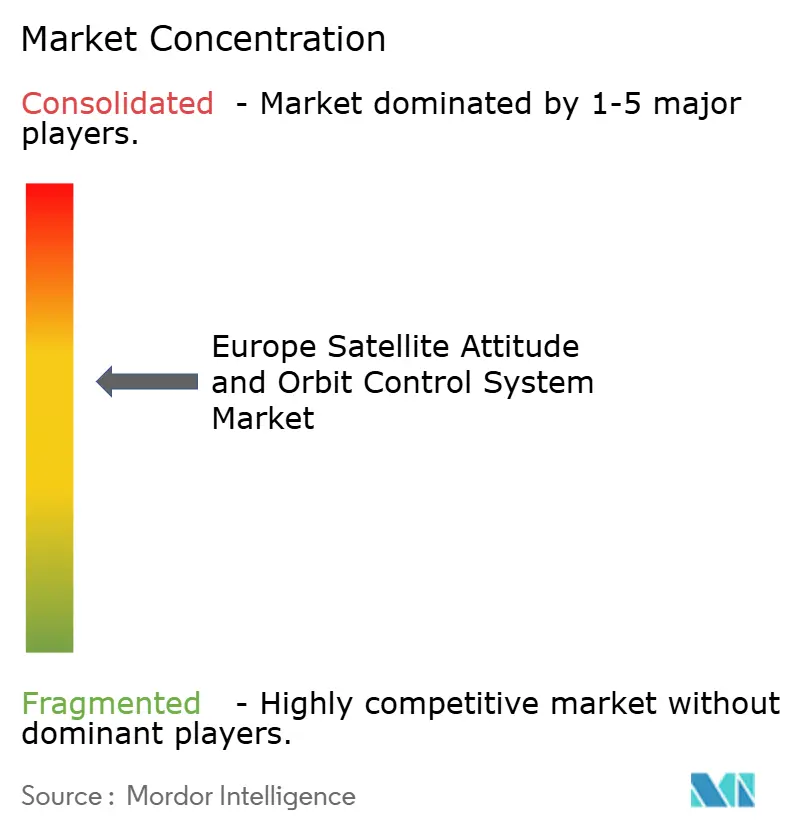
Recent Industry Developments
- October 2025: Airbus, Thales, and Leonardo signed a framework merger to combine their satellite manufacturing operations into a new European champion to better compete in AOCS-enabled satellite constellations.
- September 2025: The ESA disclosed that its RISE program started validating the possibility of satellite life extension through AOCS.
- December 2024: ESA awarded a EUR 290 million (USD 336.35 million) contract to the SpaceRISE consortium, led by SES, Eutelsat, and Hispasat, for IRIS²’s first 290 satellites, mandating autonomous formation-flying AOCS.
Europe Satellite Attitude And Orbit Control System Market Report Scope
| Communication |
| Earth Observation |
| Navigation |
| Space Observation |
| Others |
| Below 10 kg |
| 10 to 100 kg |
| 100 to 500 kg |
| 500 to 1000 kg |
| Above 1000 kg |
| Geostationary Earth Orbit (GEO) |
| Low Earth Orbit (LEO) |
| Medium Earth Orbit (MEO) |
| Commercial |
| Military and Government |
| Other |
| United Kingdom |
| France |
| Germany |
| Russia |
| Rest of Europe |
| By Application | Communication |
| Earth Observation | |
| Navigation | |
| Space Observation | |
| Others | |
| By Satellite Mass | Below 10 kg |
| 10 to 100 kg | |
| 100 to 500 kg | |
| 500 to 1000 kg | |
| Above 1000 kg | |
| By Orbit Class | Geostationary Earth Orbit (GEO) |
| Low Earth Orbit (LEO) | |
| Medium Earth Orbit (MEO) | |
| By End User | Commercial |
| Military and Government | |
| Other | |
| By Geography | United Kingdom |
| France | |
| Germany | |
| Russia | |
| Rest of Europe |
Market Definition
- Application - Various applications or purposes of the satellites are classified into communication, earth observation, space observation, navigation, and others. The purposes listed are those self-reported by the satellite’s operator.
- End User - The primary users or end users of the satellite is described as civil (academic, amateur), commercial, government (meteorological, scientific, etc.), military. Satellites can be multi-use, for both commercial and military applications.
- Launch Vehicle MTOW - The launch vehicle MTOW (maximum take-off weight) means the maximum weight of the launch vehicle during take-off, including the weight of payload, equipment and fuel.
- Orbit Class - The satellite orbits are divided into three broad classes namely GEO, LEO, and MEO. Satellites in elliptical orbits have apogees and perigees that differ significantly from each other and categorized satellite orbits with eccentricity 0.14 and higher as elliptical.
- Propulsion tech - Under this segment, different types of satellite propulsion systems have been classified as electric, liquid-fuel and gas-based propulsion systems.
- Satellite Mass - Under this segment, different types of satellite propulsion systems have been classified as electric, liquid-fuel and gas-based propulsion systems.
- Satellite Subsystem - All the components and subsystems which includes propellants, buses, solar panels, other hardware of satellites are included under this segment.
| Keyword | Definition |
|---|---|
| Attitude Control | The orientation of the satellite relative to the Earth and the sun. |
| INTELSAT | The International Telecommunications Satellite Organization operates a network of satellites for international transmission. |
| Geostationary Earth Orbit (GEO) | Geostationary satellites in Earth orbit 35,786 km (22,282 mi) above the equator in the same direction and at the same speed as the earth rotates on its axis, making them appear fixed in the sky. |
| Low Earth Orbit (LEO) | Low Earth Orbit satellites orbit from 160-2000km above the earth, take approximately 1.5 hours for a full orbit and only cover a portion of the earth’s surface. |
| Medium Earth Orbit (MEO) | MEO satellites are located above LEO and below GEO satellites and typically travel in an elliptical orbit over the North and South Pole or in an equatorial orbit. |
| Very Small Aperture Terminal (VSAT) | Very Small Aperture Terminal is an antenna that is typically less than 3 meters in diameter |
| CubeSat | CubeSat is a class of miniature satellites based on a form factor consisting of 10 cm cubes. CubeSats weigh no more than 2 kg per unit and typically use commercially available components for their construction and electronics. |
| Small Satellite Launch Vehicles (SSLVs) | Small Satellite Launch Vehicle (SSLV) is a three-stage Launch Vehicle configured with three Solid Propulsion Stages and a liquid propulsion-based Velocity Trimming Module (VTM) as a terminal stage |
| Space Mining | Asteroid mining is the hypothesis of extracting material from asteroids and other asteroids, including near-Earth objects. |
| Nano Satellites | Nanosatellites are loosely defined as any satellite weighing less than 10 kilograms. |
| Automatic Identification System (AIS) | Automatic identification system (AIS) is an automatic tracking system used to identify and locate ships by exchanging electronic data with other nearby ships, AIS base stations, and satellites. Satellite AIS (S-AIS) is the term used to describe when a satellite is used to detect AIS signatures. |
| Reusable launch vehicles (RLVs) | Reusable launch vehicle (RLV) means a launch vehicle that is designed to return to Earth substantially intact and therefore may be launched more than one time or that contains vehicle stages that may be recovered by a launch operator for future use in the operation of a substantially similar launch vehicle. |
| Apogee | The point in an elliptical satellite orbit which is farthest from the surface of the earth. Geosynchronous satellites which maintain circular orbits around the earth are first launched into highly elliptical orbits with apogees of 22,237 miles. |
Research Methodology
Mordor Intelligence follows a four-step methodology in all our reports.
- Step-1: Identify Key Variables: In order to build a robust forecasting methodology, the variables and factors identified in Step-1 are tested against available historical market numbers. Through an iterative process, the variables required for market forecast are set and the model is built on the basis of these variables.
- Step-2: Build a Market Model: Market-size estimations for the historical and forecast years have been provided in revenue and volume terms. For sales conversion to volume, the average selling price (ASP) is kept constant throughout the forecast period for each country, and inflation is not a part of the pricing.
- Step-3: Validate and Finalize: In this important step, all market numbers, variables and analyst calls are validated through an extensive network of primary research experts from the market studied. The respondents are selected across levels and functions to generate a holistic picture of the market studied.
- Step-4: Research Outputs: Syndicated Reports, Custom Consulting Assignments, Databases & Subscription Platforms.
